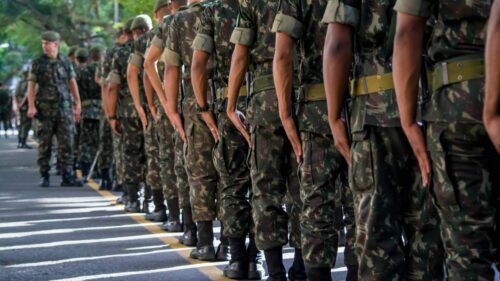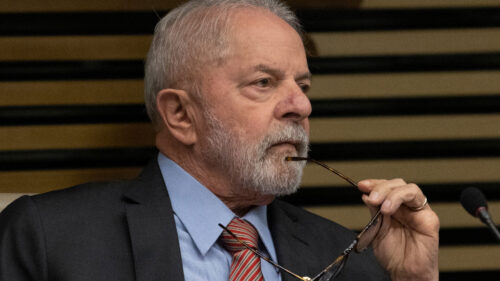Rio de Janeiro has become a scene of horror. Throughout the city, criminal militias coerce and paralyze millions of citizens in a battle for dominance. They have unleashed mass violence on Rio de Janeiro and brought the city to a standstill.
On October 23 last year, the Carioca militia — a sort of hybrid mafia and extralegal police force — set fire to 35 buses and a train, interrupted part of traffic with trucks, besieged seven neighborhoods and harmed around a million people. Such violence is no longer a mere criminal attack. Instead, it is an act of terrorism.
The Carioca militia engaged in this terrorist act to retaliate against the killing of Matheus da Silva Rezende, the number two in their dreaded organization. Note that Rezende was the nephew of Bonde do Zinho, the leader of the Carioca militia.
The militia’s fireworks were a message to Rio’s public authorities about the Carioca militia’s power. This organization dominates more than half of the city’s area, holding nearly two million people hostage. Violence continues to rise and only a quarter of the capital is free from the yoke of violent criminals.
To retain authority, the Brazilian state has to crack down on illegal activities and impose rule of law. The city, state and federal governments came together to respond. Yet each proposed a different solution. As long as a lack of consensus continues, Rio de Janeiro will continue to be terrorized by violent militias.
How government agents turned into vigilantes
Brazil’s militia groups (milicias) are not ordinary gangs, but criminalized groups of government agents and ex-agents. They were born in housing estates offered by the government for security personnel. Some agents created the first groups with the justification of providing security for residents against drug traffickers. In the 2000s, militias saw the accessibility vacuum to public services as an opportunity. By offering vans to travel to central regions, the militias increased their financial power. Soon enough other opportunities were added to the militias’ menu. They began to charge for gas, water, electricity, cable TV and real estate services, solidifying an illegal parallel power.
Thus, Rio became divided between militias and drug cartels. However, in 2014, the last of the five militia commanders who had originated from police forces was arrested. The leadership of the militia group went to former drug trafficker Carlinhos Três Pontes. In a modality known as narcomilicia, the business also expanded into the drug trade.
This merger proved successful for the expansion of Carioca militias. Between 2017 and 2021, militias doubled the size of the area they occupy in the city. The most recent study by GENI (New Illegalisms Study Group) and the Fogo Cruzado (Crossfire) institute shows that a total of 73% of Rio’s land area is occupied by militias and drug cartels.
This is why the retaliation of the Carioca militia in response to the killing of da Silva Rezende is so important to the paramilitary group. Not only was it important to the group’s line of succession, but also because da Silva Rezende was the negotiating link between traffickers and militiamen.
Criminal control trumps legal authority in Rio’s streets
With narcomilicia, criminal power becomes the de facto legislative, judicial and executive power without regard for legal authority. It doesn’t help that the city has only one police station specializing in this type of crime, the Police Station for the Repression of Organized Criminal Actions (DRACO). It has 40 police officers.
However, it is not only the lack of resources that has led to the rise of criminal control. The dominance of militia power comes as no surprise when even legal powers escalate outside the law. The issue of violence has been the responsibility of the Civil Police since Governor Wilson Witzel abolished the Public Security Secretariat (SSP) in 2019. With the extinction of the SSP, the police forces no longer had to follow state policies and began to act on their own. This scenario led to a second explosion of militia groups, except that in this case they infiltrated all spheres of power.
“The extinction of the secretariat was decisive since it eliminated the institution of police coordination and the question of civil and political control. It favors the logic of expansion of the [militia] groups since they can develop freely within the security forces and there is no proper control of police activity,” says Daniel Hirata, a sociologist who heads the New Illegalisms Study Group (GENI/UFF). With less oversight, Rio’s Civil Police have formed connections with paramilitary groups. It is clear that police deployment within the city is not an adequate solution.
Fighting violence with violence and police corruption
Despite this clear connection, Minister of Justice and Public Security Flávio Dino advised President Lula da Silva to deploy federal forces in the city. A total of 300 National Public Security Force agents and 270 federal highway police were deployed. Dino sent Executive Secretary Ricardo Cappelli, National Secretary for Public Security Tadeu Alencar and Commander of the National Force Fernando Alencar de Medeiros to the state.
After a meeting with Rio’s Governor Cláudio Castro, Cappelli announced the creation of a group to investigate money laundering and “financially asphyxiate criminal organizations and reduce their offensive potential.” According to Cappelli, expanding the Federal Police’s intelligence work is the focus. However, Cappelli has also stated that the government will continue to expand the presence of the Federal Police and the National Force within city limits. “We have increased the number of personnel with a group led by the National Secretariat for Public Security investigating the connections between factions in Rio and other states,” said Flávio Dino. He ruled out federal intervention, but the case reinforced opinions in favor of dividing his ministry between Justice and Public Security. Clearly the federal government believes that increased military presence will stop the violence on Rio’s streets. However, data groups such as GENI think differently.
In regards to violence, Daniel Hirata suggests data-based planning: “We need to work in a regulatory and not just a repressive way, investigating links between criminal groups and politicians, so that those who should be tackling crime are not co-opted by it. Only repressive action brings poor results in dismantling criminal networks.”
Political scientist Emmanuel Nunes agrees. “Overt policing must have the same presence regardless of the social profile of the locality,” he states. “Finally, the investigation and punishment of those involved with paramilitary groups. The role of the Civil and Federal Police is central to this process.”
Rio de Janeiro should be focused on confronting violence at the source. Fighting violence with violence, as Dino and Cappelli suggested, will not work when militias have pervaded multiple spheres of power. Only when the government confronts the issue of corruption shall the city make progress tackling violence.
[Cheyenne Torres edited this piece.]
The views expressed in this article are the author’s own and do not necessarily reflect Fair Observer’s editorial policy.
Support Fair Observer
We rely on your support for our independence, diversity and quality.
For more than 10 years, Fair Observer has been free, fair and independent. No billionaire owns us, no advertisers control us. We are a reader-supported nonprofit. Unlike many other publications, we keep our content free for readers regardless of where they live or whether they can afford to pay. We have no paywalls and no ads.
In the post-truth era of fake news, echo chambers and filter bubbles, we publish a plurality of perspectives from around the world. Anyone can publish with us, but everyone goes through a rigorous editorial process. So, you get fact-checked, well-reasoned content instead of noise.
We publish 2,500+ voices from 90+ countries. We also conduct education and training programs
on subjects ranging from digital media and journalism to writing and critical thinking. This
doesn’t come cheap. Servers, editors, trainers and web developers cost
money.
Please consider supporting us on a regular basis as a recurring donor or a
sustaining member.
Will you support FO’s journalism?
We rely on your support for our independence, diversity and quality.







Comment